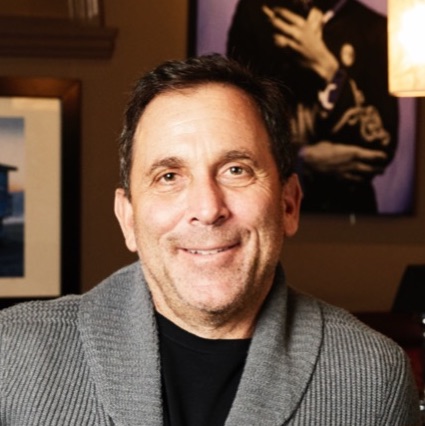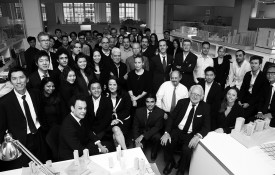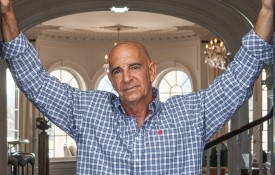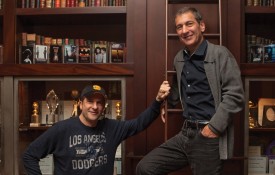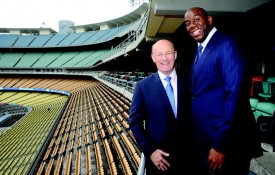Mike Meldman’s career has taken him from dealing cards to selling farmland, and most recently, to doing billion-dollar deals with George Clooney. But you’re most likely to know him as your favorite celebrity’s favorite real estate developer.
He’s more comfortable in jeans than tailored suits, but don’t let the casual, fun-loving facade and colorful backstory distract from the serious powerhouse underneath. Meldman is a self-made real estate mogul who has built his Discovery Land Company, where he serves as chairman and CEO, into one of the biggest resort-community developers in the country, with 23 luxury communities built or under construction.
From its start with the Estancia Club in Scottsdale, Ariz., Discovery Land Company, which has offices in Scottsdale, Ariz. and Beverly Hills, has established an empire stretching across the country and beyond, to the Bahamas, Mexico, and Portugal. Its latest development is Meldman’s first in the Northeast, Silo Ridge, in New York’s Hudson Valley. The first buyers there: the power couple of supermodel Gisele Bündchen and Tampa Bay Buccaneers quarterback Tom Brady.

Mike Meldman’s development Silo Ridge in New York’s Hudson Valley has been popular with celebrities like Tom Brady.
Owners at Discovery Land Company’s other properties include a roster of similarly familiar names, including Meldman’s business partners, actor George Clooney and nightlife impresario Rande Gerber. How has Meldman become the resort developer of choice for some of the most pampered and demanding customers anywhere? The same principle any high school or club operates under: Everyone wants to be where the cool people are. And Discovery Land Company has the coolest.
“The network and the brand has been a huge, huge asset for us,” Meldman tells us on a phone interview during quarantine from The Madison Club in La Quinta, Calif.
That cachet and brand loyalty have allowed Meldman to be the rare developer who hasn’t belly flopped during a market crash. Discovery Land Company knows how the most famous people in the world want to vacation. And even during the COVID-19 pandemic, when he builds it, they will come.
“We take land development—probably the riskiest, hardest part of the real estate business—and we de-risk it because we know what we’re doing. We have the experience, equity in our brand, and more than 15,000 members, who, when we start a new project, are ready to buy in,” he says.
Lucky Draw
Meldman grew up in a close-knit family in Milwaukee, Wis. His father sold life insurance, and his mother stayed at home and raised their kids. He had a self-described “Norman Rockwell” childhood, spending time with his large family and playing every sport. The family moved to the Phoenix area when Meldman was 12, like so many other Midwestern families did at the time, looking for sunnier skies and brighter opportunities.
Meldman adjusted well to the cross-country move, making lots of friends and doing well enough in school to get into Stanford University, destined for a career in law. His father held a law degree from Marquette University, and there were lawyers throughout the family. There was just one problem: Meldman bombed the LSAT so hard he didn’t even apply to a single law school out of embarrassment, forcing him to find a plan B.
“It was probably the best thing that’s ever happened to me,” Meldman says.
It didn’t seem that way at first. Instead, while his Stanford classmates followed the well-trodden—and well-heeled—path to white-shoe law firms and Silicon Valley startups, Meldman headed east on Interstate 80 toward Lake Tahoe, where he took a job dealing blackjack at Harrah’s.

In addition to real estate, Meldman also co-founded the tequila brand Casamigos.
“That didn’t sit well with my parents that well after all the money they spent on Stanford,” he says.
His next step didn’t make them feel much better, as Meldman took a job as a broker for a real estate startup, Bishop Hawk, working on commission only. Until he started making deals, he continued dealing cards in Tahoe and bartending on weekends. But this was the break that would put him on the map.
Bishop Hawk assigned Meldman to the East Bay town of Fremont, which he says was at the time “a bunch of farmland.” But it was primed to take off, turbocharged by tech money, and Meldman would be at the heart of it.
As Silicon Valley expanded south and east from Palo Alto through Mountain View and then into much more distant San Jose and Milpitas, Fremont’s location across the Dumbarton Bridge from Palo Alto became much more attractive. Meldman followed the real estate rule of getting signs up, and people came calling almost immediately.
His first year in the business, Meldman made a lot of small deals—some as little as two figures after commissions were split with other brokers. But he learned a lot.
“The positive part was I was making deals,” Meldman says. “I kind of had a knack for making deals.”
Soon, those numbers began to get much bigger.
“All of a sudden, all these farms I had signs on, developers started buying,” Meldman says. “My second year in the business, I ended up selling all of Fremont. It was a huge success for a young guy one year out of college making all these deals.”
He then went to work for one of the developers he’d sold property to, handling marketing and interacting with brokers. The money was great, but after about his third year, Meldman wanted a piece of the action instead of just helping make it happen. When the developer imploded during the savings and loan crisis and the knives came out, Meldman felt it was a good time to strike out on his own as a principal.
“When you are the agent, you don’t really have any control over anything,” he says. “You don’t know who’s doing what, or if someone’s telling you the truth. I didn’t like that because I’d commit to something and put a lot of work into it and the guy had no intention of really doing anything.”
Meldman had plenty of intentions of doing much bigger things, starting just down the road from his alma mater.

An overview of the El Dorado development in Los Cabos.
Golden Road
Meldman’s first development project would have been the last for most developers: an 18-year odyssey in Northern California. But he’s not most developers.
When Meldman went out on his own as a developer, he had enough money to be comfortable, but not to do his own deals. He knew that land that had been entitled was more valuable than unentitled land—he had seen that firsthand selling farmland to big developers—and he made that the cornerstone of his strategy, recruiting a friend to partner up.
“The one thing I learned how to do from my brokerage days was tie up land,” Meldman says. “And then go through and get the land entitled.”
The first property he bought was a 300-acre site in Portola Valley, a suburb of Stanford, that was zoned for 32 houses. He raised funds through the fathers of some friends. “They put the money up, I did the work,” Meldman says. There was just one problem. “This land we bought had every environmental constraint you could think of.”
It ultimately took Meldman 18 years to build 28 homes on those 300 acres. Even in California, where new housing is often treated by neighbors as if someone had proposed a nuclear waste disposal facility in their front yards, it was an especially difficult process.
However, the experience was hugely valuable, as Meldman learned how to develop through every possible environmental roadblock, at a time when environmental guidelines were not as exhaustive as they are now. That experience would serve him well on future developments with larger stakes. “I feel like I got a PhD in development because I had to do this right,” Meldman says.
He also received a second Stanford education, of sorts, in trying to win over the volunteers on the planning committees who held his project in the balance. He laid the roads in a contoured way, to avoid mass grading the site. He put houses on knolls with driveways designed not to disturb the grade. On top of that, the San Andreas Fault ran through the site, which was designated as a wildlife corridor.
“Because it was a suburb of Stanford, all the volunteer people on the committees were Stanford professors,” Meldman says. “For the San Andreas Fault, you’re dealing with the guy who started the [United States Geological Survey]. I had to know what I was doing. They would eat you alive.” The Portola Valley development ended up taking the majority of Meldman’s time between about 1985 and 1995. He spent much of the balance developing another project that involved a golf course and several homes.
While spending years in a planning morass is usually not a recommended strategy for real estate developers, Meldman benefited from this stasis. The early-to-mid-1990s was not a fruitful time for real estate developers, as the Resolution Trust Corporation was unloading mortgage loans and the market was generally depressed. Shepherding large developments through a slow entitlement process turned out to be a good use of Meldman’s time.
“The market wasn’t there for anything anyway,” he says. “The motto was ‘Stay alive to ’95.’ I wasn’t strategic, but the timing worked that way.”

The gates to El Dorado in Los Cabos.
Reaching the Pinnacle
After his experiences in California, Meldman decided to try his luck in other parts of the country where the process of getting approvals to develop was not quite as excruciating. That took him back to his home state of Arizona.
This was the mid-1990s, when city planners in the affluent Phoenix suburb of Scottsdale were trying to be more environmentally sensitive. Arizona was depressed, but housing in the area was showing signs of taking off, along with other Sun Belt cities like Las Vegas.
Meldman put the word out to friends that he was on the hunt for property, and soon got a call from Mark Sollenberger, who still works with Meldman today. Sollenberger mentioned that he had a property for sale: Pinnacle Peak, a landmark mountain in the area. Meldman was in. “I had no idea how I was going to buy it,” he says. “But I tied it up.”
Meldman hired a group from New York called BDS to go on a road show to raise money. During the first meeting, Meldman was shocked to learn BDS stood for something along the lines of “bankrupt distressed specialists.” Nevertheless, BDS did a good job, and were able to raise the money. Every person they met wanted to be involved in the project.
Ironically, the day he went to look at the property, friends and colleagues tried to talk him out of building a brand-new golf resort community in Scottsdale, home of arguably the largest concentration of luxury golf courses in the country. Their doubts were unwarranted.
Meldman, who then did not play golf, relied on Sollenberger, an accomplished golfer, to help shape the idea for Estancia. The logic was “golf and open space sells real space for premiums and higher velocities,” Meldman says. They built the course and the Pinnacle Peak trail system, and the strategy worked.
Estancia’s lots and land sold for four to five times what properties outside its gates were going for. It was home to the first few lots that sold for more than $1M in the state. “It was the place to be,” Meldman says. “It’s still probably the best golf course in Arizona 25 years later.”

Meldman in front of his other Los Cabos project, Chileno Bay.
On the Map
After Estancia, Meldman was emboldened to come back to California for a project called CordeValle, in the foothills near Gilroy, Calif. A lot of Estancia members were Bay Area tech moguls, including legendary venture capitalist Don Valentine, which convinced Meldman that there was a market for a “CEO club” for Silicon Valley.
The site did not have a huge residential real estate component, but Discovery Land Company developed the golf course and hotel, which today is the Rosewood CordeValle. CordeValle’s success acted as a catalyst for a subsequent string of developments, including Kuki’o, on the Big Island of Hawaii, Mirabel, in Scottsdale, and Iron Horse, in Whitefish, Mont.
Meldman tells the story of how he made his first sales at Iron Horse: He brought four friends to the site in a private jet, all of whom told him in advance that they were not interested. The group toured the golf course then went fishing and whitewater rafting in Glacier National Park.
“The idea was basically to turn you into a mountain man,” Meldman says. “The whole idea outside of the golf for Iron Horse was to take advantage of what the local culture had to offer, all the great things to do in northern Montana.” All four ended up buying.
Iron Horse was the first Discovery Land Company development to add what Meldman calls “Outdoor Pursuits,” where longtime local guides take members to experience recreational activities, like wakeboarding and fly-fishing.
Meldman has also made local the focus of his charitable work, through the Discovery Land Company Foundation. The foundation organizes events like celebrity pro-am tournaments, with all the money going to area charities.
Growing the Empire
Discovery Land Company’s next string of developments included its first outside the United States: El Dorado Golf & Beach Club in Cabo San Lucas, Mexico, as well as The Madison Club and Gozzer Ranch Golf & Lake Club in Coeur d’Alene, Idaho. That international footprint has since expanded in the now 25-plus clubs Discovery Land Company has either built or has in the works, including Baker’s Bay Golf & Ocean Club in the Bahamas, and its first in Europe: CostaTerra Golf & Ocean Club on Portugal’s Alentejo coast.
Discovery Land Company’s business, involving slow-moving, time-consuming residential developments in resort communities, would seemingly be sensitive to shocks in the economy. However, the company thrived in the 2008 recession, adding one of its crown jewels: Yellowstone Club in Big Sky, Mont.
“We came in at the right time and we turned that around,” Meldman says. “The bones were all there and were great, except for it was in bankruptcy.”
He fixed up the master plan and added resort-style amenities, and the business took off. Members include a host of Silicon Valley titans. Last year, Yellowstone did $1B in sales, according to Meldman.
“It’s all vertically integrated, so we know how to make it work,” Meldman says. “Not only from a development standpoint, but also from a cultural standpoint.”
Meldman chalks up his ability to thrive during real estate downturns to the specific business model of Discovery Land Company. He has reduced risk in the business model by essentially having a preselected—and highly convertible—pool of customers. And most important, the company has no debt, and neither do most of its projects.
“What I learned is, you think it’s going to take you a year to get approved and it may take 18 years,” Meldman says. “If I would have had debt on Portola Valley I would never have made it 18 years.”
Meldman says he prefers to take on equity partners rather than use debt because it’s safer and gives him the freedom not to worry about market cycles. And now, with so many communities, selling to guests of other members alone presents a huge potential customer base.
“Now that we have so many clubs, we probably do 100,000 guest rounds a year,” he says. “All those guests are potential buyers somewhere else. We are able to market without spending real money. My whole idea from a marketing standpoint is: Get them when they’re on property.”
Discovery Land Company’s latest, Silo Ridge, is conveniently located for the country’s finance elite, an easy drive from New York City. Meldman believes Discovery Land Company projects like Silo Ridge are well-positioned for a world in which people might be reluctant to live or vacation in crowded mega-cities but want amenities and easy access if needed.
“In today’s world, people want the private, low-density projects away from tourist destinations,” he says.
That seems to be proving true at several Discovery Land Company properties. At Yellowstone Club, Meldman made sure to keep the restaurant open even after the county closed down the resort facilities. That’s allowed the community to deliver food to the 100 families quarantining at Yellowstone, many of whom, Meldman says, are using the community as a “safe haven” away from their homes in places like Boston and Los Angeles. Silo Ridge has proven to be a popular destination for its members to ride out the pandemic, as well.
“During the crisis here, every member who has a house here has stayed at their house in Silo versus being in the city, and they feel much more safe and secure,” Meldman says.

Meldman is now an avid golfer and often hosts celebrity-attended tournaments at his clubs.
Home on the Range
Welsh soccer star Gareth Bale made headlines three years ago when he played a round of golf at Baker’s Bay wearing nothing but underwear. While that’s not exactly par for the course at Discovery Land Company properties, Meldman has gone against the grain of many exclusive-club developers and deliberately made his properties casual and welcoming to families.
Meldman says a lot of this happened organically, as he was dealing with his own young kids and had a natural, casual inclination. When he built Estancia, the clubhouse originally had a no cell phones and no jeans rule, like pretty much every other golf club in Arizona. After a while, Meldman got tired of changing out of jeans every time he wanted to use the clubhouse, thinking it was “the dumbest thing ever.”
“Wear jeans in the clubhouse, who cares?” he says. “I did it, and people liked it.” The collared-shirt rule went out the window soon after. Meldman wanted to golf with his children, who were around 5 and 7, and had to literally wrestle with them to get them into collared shirts. He decided this was not worth the fight, and removed the requirement. Guests can now golf in a T-shirt or no shirt at all at Discovery Land Company properties—though Bale might be better suited for that than most.
Interestingly enough, Meldman says that if he had the appreciation then for golf that he does now as a longtime player rather than a new golfer, he may not have been so cavalier in bending the rules.
“Golf is very traditional,” he says. “The tradition and history of the game is very important. Now, 25 years later, I love golf and I’m a big golfer, and I do appreciate the history. If I understood that back then, I might not have done this.” However, Discovery Land Company’s casual approach reduces the intimidation factor of golf clubs, which Meldman says has worked well. “I try to take that fear factor away,” he says.
Meldman has also strayed from the golf course orthodoxy in terms of food. Many golf courses have halfway houses or huts where golfers can grab a granola bar, soft drink, or maybe a hot dog to refuel them as they power through the back nine.
Compare Discovery Land Company’s “Comfort Stations,” which originated from an idea Meldman had to stash fun snacks in coolers at every tee box to entertain his kids. Now, the stations at his clubs include everything from milkshakes and frozen margaritas to a full-on candy stand. “The whole idea was just to make the golf course fun,” he says.

Meldman with his friends and Casamigos partners George Clooney and Rande Gerber.
The Three Amigos
While Meldman’s primary business is developing some of the most exclusive resort communities in the world, he’s likely better known to most people as one of the three men behind a brand with a much lower price of entry: Casamigos Tequila.
Meldman met Gerber and Clooney more than 20 years ago, and then the two went on to build houses at his El Dorado Golf & Beach Club. Over the course of many conversations overlooking the Sea of Cortez, they came up with a simple, bulletproof business plan: “I figured I did enough projects, I could buy enough to make it successful,” Meldman says. “Rande’s bars could buy enough to make it successful. And we figured George would drink enough to make it successful.”
The tequila had such a good reception among friends and family that the partners took it to Southern Wine & Spirits and secured a distribution deal. Meldman estimates that Casamigos sold 10,000 cases in its first week. The three sold the company to spirits giant Diageo in 2017 in a deal that could be worth up to $1B.
In a Business Insider article about the company, Gerber called Meldman “wonderful at marketing” and said he is “smart” with “incredible relationships.” However, Casamigos isn’t Meldman’s first foray into the food and beverage industry. He was an original investor in L.A. hot spot Craig’s, which repaid the favor with an eponymous dish on the menu.
Meldman’s Honey Truffle Chicken is served with spinach, a pancake, and truffle honey. Like its namesake, the dish has varied, fun elements that might not or even should not work together, but somehow do.








































